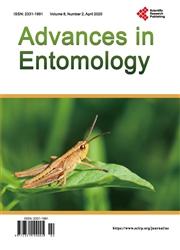The Biology of Szelenyiopria talitae (Hymenoptera: Diapriidae): Larval Parasitoid of the Leaf-Cutting Ant Acromyrmex subterraneus (Hymenoptera: Formicidae)
引用次数: 0
Abstract
The biology of a koinobiont parasitoid of leaf-cutting ant larvae, Szelenyiopria talitae (Hymenoptera: Diapriidae), was studied from naturally infested Acromyrmex subterraneus (Hymenoptera: Formicidae) nests. Nests were collected in the field from the Atlantic rainforest biome in the state of Rio de Janeiro. A total of fifty-three nests were collected from 2015 to 2018. Parasitized nests were only found during the months of September and October. Approximately 22% of the nests collected over a four-year period were found to have been parasitized by S. talitae. The mean within-nest parasitism rate was 66.3%. This diapriid displayed both solitary (14%) and gregarious parasitism (86%), with up to a maximum of 12 parasitoids developing within a single host. Gregarious parasitism with two (29%) or three (21%) S. talitae per host was most frequently observed. There was a positive correlation between the number of parasitoids per host and host size (dry weight), indicating that S. talitae females oviposited a higher number of eggs in larger hosts. There was also a negative correlation between S. talitae pharate adult size and the number of parasitoids per host, which could have been caused by sibling competition for limited host resources. The high levels of parasitism seen here had a debilitating effect on the colonies. Acromyrmex subterraneus is a serious pest in Brazil, and these studies lay the foundation for understanding the impact of S. talitae on ant populations.切叶蚁(膜翅目:蚁科)幼虫寄生蜂的生物学研究
从自然感染的Acromyrmex subterraneus(膜翅目:蚁科)巢穴中,研究了一种切叶蚁幼虫的寄生蜂Szelenyiopria talitae(膜翅目:Diapridae)的生物学特性。鸟巢是从里约热内卢州的大西洋雨林生物群落中采集的。从2015年到2018年,共收集了五十三个巢穴。寄生巢穴只在9月和10月才被发现。在四年的时间里收集到的巢穴中,大约有22%被意大利猪笼草寄生。平均巢内寄生率为66.3%,该寄生蜂既表现为孤立寄生(14%),又表现为群居寄生(86%),单个寄主内最多可发育12种寄生蜂。最常观察到每个宿主有两个(29%)或三个(21%)意大利S.talitae的Gregarious寄生。每个宿主的寄生蜂数量与宿主大小(干重)呈正相关,这表明意大利S.talitae雌性在较大的宿主中产卵数量较多。塔氏锥虫成虫大小与每个寄主的寄生蜂数量之间也存在负相关,这可能是由于兄弟姐妹争夺有限的寄主资源造成的。这里看到的高水平寄生对群落产生了削弱作用。Acrommyrmex subterraneus是巴西的一种严重害虫,这些研究为了解意大利蚁对蚂蚁种群的影响奠定了基础。
本文章由计算机程序翻译,如有差异,请以英文原文为准。
求助全文
约1分钟内获得全文
求助全文

 求助内容:
求助内容: 应助结果提醒方式:
应助结果提醒方式:


